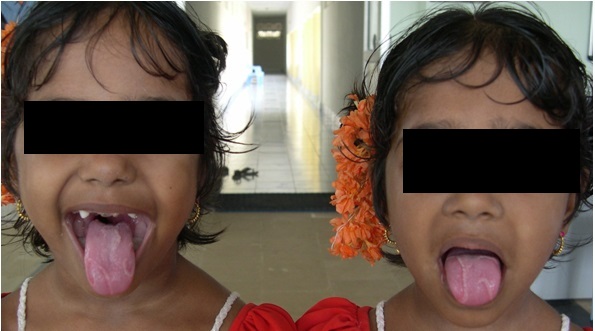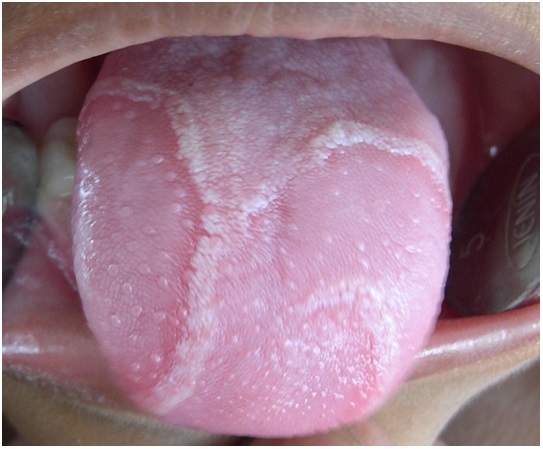Geographic Tongue in Monozygotic Twins
Guna Shekhar M1
1 Professor and Consultant Paediatric Dentist, Department of Paediatric Dentistry, Bangalore, India.
NAME, ADDRESS, E-MAIL ID OF THE CORRESPONDING AUTHOR: Dr. Guna Shekhar M., C/o Dentacare Clinic, 11 Main, 33 Cross, Next to Pai Vijay Hall, 4th T Block, Jayanagar, Bangalore-102, India.
E-mail: indshe117@gmail.com
This article discusses a case of 5-year-old girl monozygotic twins who were suffering from geographic tongue (GT), a benign inflammatory disorder of the tongue which is characterized by circinate, irregular erythematous lesions on the dorsum and lateral borders of the tongue caused by loss of filiform papillae of the tongue epithelium. Whilst geographic tongue is a common entity, reports on this condition are uncommon in the literature. To best of our knowledge, this is the first report which has described monozygotic twins with geographic tongue in the literature.
Monozygotic twins, Geographic tongue, Emotional stress, Benign migratory glossitis
Case Report
A 5-year-old girl presented to our paediatric dental unit for a routine dental check up. Detailed anamnesis revealed that the patient had been experiencing mild oral discomfort and burning sensation since a year, which increased on consumption of spicy food. Further, the parents also reported that they had noted similar episodes which were associated with discomfort at the time of her academic examinations at school. Whilst these symptoms would resolve spontaneously without any treatment, they recurred in new locations with varying patterns and sizes over a period of time. Medical and family histories were non-contributory, except that the patient’s younger sibling (monozygotic twin) also had similar episodes which involved lesions on her tongue [Table/Fig-1]. Upon consultation with a physician six months back, a possible vitamin-B deficiency was suggested and vitamin-B capsules were advised. However, no improvement in the condition was noted by the parents.
Monozygotic twins affected with geographic tongue

Clinical examination revealed well circumscribed, multifocal, patchy, irregular areas of surface erosion, with depapillation on the dorsum and lateral borders of the tongue. The periphery showed slightly elevated whitish keratotic bands enclosing the lesion [Table/Fig-2]. Extraoral examination done, which involved the scalp, nails, palms/soles and eyes yielded negative findings. The typical clinical appearance and history of the condition, including the migratory pattern and absence of significant pain, confirmed the diagnosis of geographic tongue or benign migratory glossitis. Symptomatic treatment with topical lignocaine gel was advised, owing to the spontaneous resolution of the symptoms. Further, reduction in the intake of acidic or spicy foods was advised and the patients were advised to visit once in three months for periodic follow-ups.
Lesions manifesting as multiple atrophic patches bounded by elevated whitish keratotic bands

Discussion
Synonyms of GT include benign migratory glossitis, erythema migrans, annulus migrans or wandering rash of the tongue. The prevalence of GT in general population ranges from 1.0 to 2.5% and it is more prominent in adults than in children [1]. No definitive gender predilection has been reported [2,3].
Specific cause of GT remains unknown. Various aetiological factors which have been suggested in the literature include allergy [2], emotional stress [3,4], and systemic conditions like diabetes and psoriasis [5,6]. Whilst none of the proposed aetiological factors provide a definitive evidence of a causal relationship, few authors suggested a possible significant role of psychosomatic and genetic factors in the pathogenesis of GT, owing to its increased occurrence during periods of emotional stress; and also higher prevalences in parent and sibling combinations than in general population [3].
Geographic tongue is usually diagnosed, based on its unique clinical features, including migratory pattern and a histopathologic confirmation is rarely needed; no such lesions were evident and hence, a biopsy was not performed in the present case. In the present case, the aetiology could be related to the emotional stress which was associated with their academic examinations and also, intake of spicy food. This observation was consistent with the findings of Ebrahimi et al., [7], who also reported an association between stress and GT. Furthermore, the occurrence of a similar condition in both the monozygotic twins might indicate the possible role of genetic factors and this warrants further investigation.
Whilst topical or systemic antihistamines are used in symptomatic cases [8] owing to their local anaesthetic effect, treatment is usually not considered to be necessary. Triamcinolone acetonide dental paste USP can be applied to the affected area at bedtime, to get relief from symptoms. Lidocaine rinse, mouth rinse of sodium bicarbonate in water, and diphenhydramine can be used for local pain relief in mildly symptomatic cases [9]. On rare occasions, where significant pain develops and/or persists, the use of systemic cyclosporine [10] or topical application of 0.1% tacrolimus ointment [11] for relieving symptoms, has been reported. Anti-fungal medication is initiated if secondary candidiasis is suspected. In the present case, symptomatic treatment with topical lignocaine and reduction in the intake of acidic or spicy foods was advised. Whilst GT is a common entity, reports on this condition are uncommon in the literature. This article can be considered to be unique, owing to the occurrence of GT in monozygotic twins, which has rarely been reported in the literature.
Conclusion
Geographic tongue is usually asymptomatic and it produces the characteristic migratory pattern on the dorsum of tongue. Whilst the aetiology of geographic tongue remains unknown, psychosomatic and genetic factors appear to play a significant role in the aetiology. Use of topical or systemic antihistamines in symptomatic cases provides relief due to their local anaesthetic effect.
[1]. Shulman JD, Prevalence of oral mucosal lesions in children and youths in the USAInt J Paediatr Dent 2005 2:89-97. [Google Scholar]
[2]. Miloglu O, Göregen M, Akgül HM, Acemoglu H, The prevalence and risk factors associated with benign migratory glossitis lesions in 7619 Turkish dental outpatientsOral Surg Oral Med Oral Pathol Oral Radiol Endod 2009 107:e29-33. [Google Scholar]
[3]. Redman RS, Vance FL, Gorlin RJ, Psychological component in the etiology of geographic tongueJ Dent Res 1966 45:1403-8. [Google Scholar]
[4]. Jainkittivong A, Langlais RP, Geographic tongue: clinical characteristics of 188 casesJ Contemp Dent Pract 2005 6:123-35. [Google Scholar]
[5]. Femiano F, Geographic tongue (migrant glossitis) and psoriasisMinerva Stomatol 2001 50:213-17. [Google Scholar]
[6]. Zargari O, The prevalence and significance of fissured tongue and geographical tongue in psoriatic patientsClin Exp Dermatol 2006 31:192-5. [Google Scholar]
[7]. Ebrahimi H, Pourshahidi S, Andisheh Tadbir A, Bakhshi Shyan S, The Relationship between Geographic Tongue and StressIran Red Crescent Med J 2010 12:313-5. [Google Scholar]
[8]. Assimakopulos D, Patrikakos G, Fotika C, Benign migratory glossitis or geographic tongue: An enigmatic oral lesionAm J Med 2002 113:751-55. [Google Scholar]
[9]. Neville BW, Damm DD, Allen CM, Bouquot JE, Dermatologic diseases In: Oral and maxillofacial Pathology 2002 3rd EdSt Louis, MoSaunders Elsevier:779-81. [Google Scholar]
[10]. Abe M, Sogabe Y, Syuto T, Ishibuchi H, Yokoyama Y, Ishikawa O, Successful treatment with cyclosporin administration for persistent benign migratory glossitisJ Dermatol 2007 34:340-3. [Google Scholar]
[11]. Masaya Ishibashi, Genichi Tojo, Masahiko Watanabe, Takahiro Tamabuchi, Takashi Masu, Setsuya Aiba, Geographic tongue treated with topical tacrolimusJ Dermatol Case Rep 2010 4:57-9. [Google Scholar]